Jar
A jar is a rigid, cylindrical or slightly conical container, typically made of glass, ceramic, or plastic, with a wide mouth or opening that can be closed with a lid, screw cap, lug cap, cork stopper, roll-on cap, crimp-on cap, press-on cap, plastic shrink, heat sealed lidding film, an inner seal, a Tamper-evident band, or other suitable means.

_MET_DP281207.jpg)
Jars can be used to hold solids too large to be removed from, or liquids too viscous to be poured through, a bottle's neck; these may be foods, cosmetics, medications, or chemicals. [1] Glass jars—among which the most popular is the mason jar—can be used for storing and preserving items as diverse as jam, pickled gherkin, other pickles, marmalade, sun-dried tomatoes, olives, jalapeño peppers, chutneys, pickled eggs, honey, and many others.
Jars are sterilised by putting them in a pressure cooker with boiling water or an oven for a number of minutes. Glass jars are considered microwavable.[2]
Some regions[In what country?] have a legally mandated deposit refundable upon return of the jar to its retailer, after which the jar is recycled according to the SPI recycling code for the material.[3]
Etymology
The English word "jar" originates from the Arabic word jarra, which means an earthen pot or vessel.[4][5]
Types
- Bell jar in a laboratory
- Cookie jar
- Killing jar, used to kill captured insects
- Kilner jar, for food storage
- Leyden jar, a historical capacitor
- Mason jar, for food storage
- Specimen jar, an instrument used in anatomy to preserve specimens
Gallery
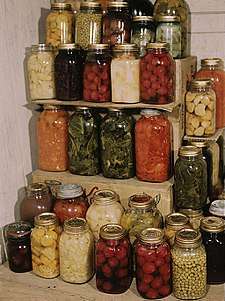 Preserved food in Mason jars
Preserved food in Mason jars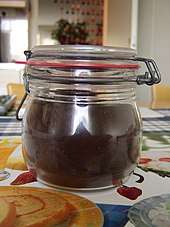 Reusable jam jar with flip-top or bail closure
Reusable jam jar with flip-top or bail closure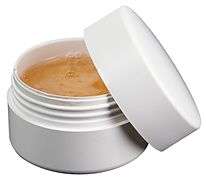 Jar made of PLA-blend bio-flex, a bioplastic
Jar made of PLA-blend bio-flex, a bioplastic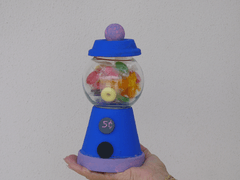 Candy jar
Candy jar- Peanut butter
 Six types of "earthenware jar" in Spain
Six types of "earthenware jar" in Spain Brown-glazed jar with design of three fish. Yuan Dynasty.
Brown-glazed jar with design of three fish. Yuan Dynasty.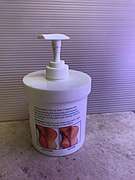 PP jar of skin cream with pump dispenser
PP jar of skin cream with pump dispenser
See also
- Amphora
- Bottle
- Canning
- Child-resistant packaging
- Cookie jar
- Jar opener
- Leyden Jar
- Tamper-evident
- Tamper resistant
- The asterism Water Jar in the constellation Aquarius
References
- Yam, K. L., "Encyclopedia of Packaging Technology", John Wiley & Sons, 2009, ISBN 978-0-470-08704-6
- Ahvenainen; Heiniö, R.-L. (1993). "Factors affecting the suitability of glass jars for heating in microwave ovens. Comparison with plastic jars and paper board tubs". Packaging Technology and Science. 6 (1): 43–52. doi:10.1002/pts.2770060108.
- Soroka, W, "Fundamentals of Packaging Technology", IoPP, 2002, ISBN 1-930268-25-4
- J. A. Abu-Haidar. Hispano-Arabic Literature and the Early Provencal Lyrics. Routledge. p. 228.
- James E Glevin. The Modern Middle East: A History. Oxford University Press. p. 21.
External links
| Look up jar in Wiktionary, the free dictionary. |

- . Encyclopædia Britannica. 15 (11th ed.). 1911.